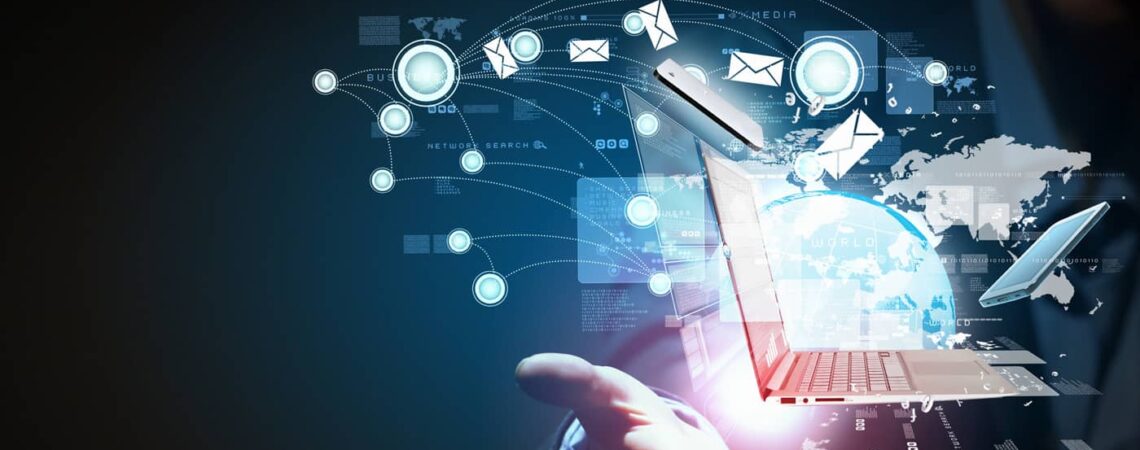
The modern office or workplace can’t think about functioning without advanced technologies. Lacking in this department will mean that the workplace in question lacks efficiency.
According to Verified Market Research, the smart offices market is projected to reach a value of $93.44 billion within the next six years. The main reason behind the high valuation of this market is the fact that more and more workplaces are adopting modern technologies.
The question is, what kind of tech contributes to the efficiency of a workplace and gives it a much-needed modern touch?
In this article, we’ll explore four must-have technologies in an efficient and modern workplace.
#1 Cloud Computing
Grand View Research reports that the global cloud computing market is worth $483.98 billion. This particular piece of tech is revolutionizing the way we define a workplace. That’s because cloud computing has enabled us to work seamlessly from anywhere in the world.
Cloud-based solutions like AWS, Microsoft Azure, and Google Cloud Platform allow employees to collaborate with one another irrespective of their geographical locations.
Documents can be shared and edited in real time, and employees can access their work-related data on various devices. This, in turn, ensures productivity is not confined to the physical office.
Furthermore, cloud computing enhances data security through robust encryption and backup solutions, providing peace of mind for both employers and employees.
This technology allows businesses to adapt to changing demands and empowers remote work, making it an indispensable asset in today’s dynamic work environment.
#2 Artificial Intelligence (AI) and Machine Learning
Artificial intelligence (AI) and machine learning (ML) have ushered in a new era of automation and decision-making in the modern workplace.
AI-powered applications and algorithms are capable of analyzing vast amounts of data, identifying patterns, and making predictions, thus significantly enhancing productivity and efficiency.
Today’s workplaces use AI and ML in various ways. Chatbots, for instance, provide instant customer support, while AI-driven analytics help businesses gain insights into customer behavior and preferences.
In human resources, AI is used to streamline the hiring process, shortlisting candidates based on their qualifications and experience.
Machine learning algorithms also play a crucial role in cybersecurity, detecting and mitigating threats in real time. As AI and ML continue to evolve, they will become increasingly essential for businesses seeking to optimize operations and make data-driven decisions.
#3 Internet of Things (IoT)
The Internet of Things (IoT) is a game-changer for businesses across industries. It refers to the network of interconnected devices and sensors that can collect and transmit data.
In a modern workplace, IoT technology can be used to enhance efficiency, reduce costs, and improve the overall work environment.
Smart offices equipped with IoT sensors can monitor and control various aspects of the workspace, such as lighting, temperature, and occupancy.
This not only creates a more comfortable and energy-efficient environment but also helps organizations reduce their carbon footprint. IoT devices can also track the usage of office resources like printers and meeting rooms, leading to better resource allocation.
Moreover, IoT plays a significant role in asset management and inventory tracking. Businesses can use IoT sensors to monitor the location and condition of valuable assets, reducing the risk of loss or theft.
These days, IoT tech is also integrated into visitor management software. These visitor management systems allow office personnel to see which of their expected guests have arrived and where they are at.
Such integrated technology is a great way for the office to show off its tech-savviness to guests, including existing and potential clients.
According to Greetly, a visitor management system allows guests to sign in and also collects visitor data in a way. With IoT integration, it’s as if the guests become a part of the office’s ecosystem.
#4 Augmented Reality (AR) and Virtual Reality (VR) Technology
VR and AR have various applications in a modern office. In the field of training and development, VR simulations allow employees to practice tasks in a safe and controlled virtual environment.
This is particularly valuable in industries where safety is paramount, such as aviation and healthcare.
AR, on the other hand, can provide real-time information and guidance to employees, enhancing their performance in tasks like maintenance and repair.
In sales and marketing, AR apps enable customers to visualize products in their own environment before making a purchase decision. This immersive experience enhances customer engagement and can lead to increased sales.
As explained by The Constructor, VR is particularly useful in architecture firms. In fact, this technology is revolutionizing the industry in a way.
VR allows for 3D modeling and virtual walkthroughs, aiding in the visualization and planning of projects. It also helps identify design flaws before the start of the building process.
Conclusion
A modern workplace is characterized by its ability to leverage cutting-edge technologies to enhance productivity, collaboration, and efficiency.
The above-discussed technologies enable organizations to adapt to the changing demands of the digital age and stay competitive in a globalized market.
Embracing these technologies is not just an option but a necessity for businesses looking to thrive in the 21st century.
As technology continues to advance, staying at the forefront of these innovations will be the key to success in the modern workplace.


